Upon arrival at the Paro International Airport, our representative will receive and transfer you to Thimphu, the capital city of Bhutan. The drive takes you through the winding road with lots of beautiful hamlets. On reaching Thimphu, check-in at the hotel.
En-route to Thimphu Simtokha Dzong located 5 km south of Thimphu. Simtokha Dzong is officially known as ‘Sangkak Zabdhon Phodrang’ or the Palace of the Profound Meaning of Secret Mantras. Built in 1629 by Shabdrung Ngawang Namgyal, it is often said to be the first dzong built in Bhutan and is a gateway to Thimphu Valley. Derived from the name sinmo (demoness) and do (stone), the site is said to have been chosen to guard over a demon that had vanished into the rock nearby.
Afternoon is at leisure.
Later visit Memorial Chorten, also known as Thimphu Chorten, a large Tibetan-style Buddhist Monastery and a popular landmark in the city with its golden spires and bells. It was built in 1974 to honor the memory of the third king, Jigme Dorji Wangchuck. The architecture of the chorten has been designed to present it as ‘one of the most visible religious structures in Thimphu’.
Altitude: 2350m / 7710 ft. / Distance and Drive Time: 52 km/ Approx. 1.5 hours



Thimphu Dzong
Breakfast at the Hotel
Then you are transferred to Taschhio Dzong to witness the Thimphu Durbchen Festival.
Thimphu Drubchen is also commonly known as Thimphu Dromchoe and it dates back to the 17th century. It was first introduced by Kuenga Gyeltshen in 1710, who was recognized as the reincarnation of Jampel Dorji, son of Zhabdrung Nawang Namgyel. The Dromchoe is celebrated 3 days prior to the Thimphu Tshechu.
During the festival, it displays the sacred dances dedicated to the chief protective deity of Bhutan, Palden Lhamo. During Thimphu Drubchen; the mask dances known as cham and folk dances are performed to bless onlookers, to teach them the Buddhist dharma, to protect them from misfortune and to exorcise all evil. It is believed that merit is gained by attending these festivals. The dances invoke the deities to wipe out misfortunes, increase good luck and grant personal wishes.
Afterwards, we shall do some Cultural sightseeing in Thimphu.
Visit the National Library of Bhutan; a four-storied eight-cornered traditional building, which looks like the central tower temple of a Bhutanese Dzong. The building that initially had a small collection of precious texts now holds an archive responsible for collecting and preserving important past, present and future documents on Bhutan for future generations. The library also has a representative collection of English and western language books mainly related to the Himalayas, Bhutan and Buddhism.
The Folk Heritage Museum is set inside a 19th century three-storied traditional building and was established in 2001. The museum houses different tools, materials, objects, equipment and artefact from rural Bhutanese households and gives a good insight of the traditional Bhutanese lifestyle.
Established in 1988, the National Institute of Traditional Medicine strives to merge the allopathic and traditional systems of healing. The institution premises has a small museum, a gift shop (where the famous herbal tea -Tsheringma- is produced) and also a training school for traditional medicine practitioners. After the closing of the institute, visitors can walk along the compound to view it from the outside.
Visit Takin Sanctuary where the National animal of Bhutan is kept under conservation.
Also visit the Big Buddha Point also known as Kunsel Phodrang, Enjoy the picturesque view of Thimphu Valley from the top.
In the evening, meet with an Astrologer who will do a reading of an astrological chart based on your birth date and place of birth. The astrologer will be at the hotel to do the readings. The readings will last about 10 -12 minutes for each guest.
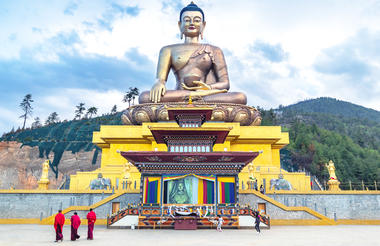
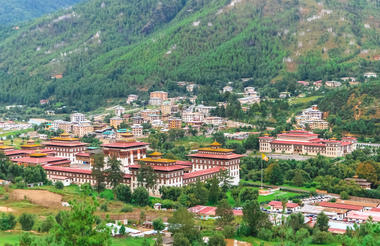
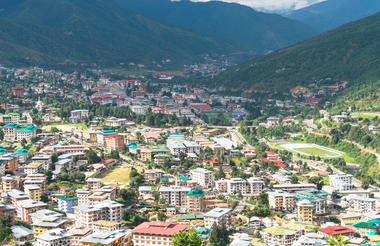
After breakfast, drive to Punakha which takes approximately 3 hours’ drive.
En-route visit the Dochula Pass which offers a 360-degree of beautiful panoramic view of the Himalayan mountain range, especially on clear winter days. There are 108 chortens that adorn this beautiful range that were built by the Queen Mother to commemorate the Bhutanese soldiers who were killed when fighting the Indian rebels in 2003.
Hang a prayer flag at the pass.
Then continue your drive to Punakha. On the way, stop at Metshina Village and take a 20-minute walk through the rice fields to Chimi Lhakhang, where many locals go to pray for progeny with great success. Lama Drukpa Kinley who was a highly unorthodox Buddhist saint whose deeds form the basis of many local legends blesses the monastery. The temple is fondly regarded as a potent fertility shrine.
Transfer to the hotel and remainder of the day is at leisure.
Altitude: 1,310m / 4300 ft. / Distance and Drive Time: 77 km/ Approx. 3 hours



Breakfast at the hotel
Then visit Punakha Dzong that was built by Shabdrung in 1637. Punakha Dzong has undergone flooding from a glacial lake high above in the mountains of Lunana, which periodically has broken through its barriers; and has been ravaged by fire, but has stood on its remarkable site since the 17th Century.
Then continue your drive to Paro which takes approx. 3 hrs.
Upon arrival in Paro visit The National Museum of Bhutan; a unique circular building also known as Ta-dzong which is an ancient watchtower above the Paro Dzong. The National Museum has in its possession over 3,000 works of Bhutanese art, rich holdings of various creative traditions and disciplines that represent a remarkable blend of the past with the present.
Paro Dzong, also known as Ringpung Dzong means ‘Fortess on a heap of jewels’. This impressive dzong is the finest example of Bhutanese architecture and is one of the most popular and well known dzongs in Bhutan.
Altitude: 2250m / 7382 ft. / Distance and Drive Time: 122km / Approx. 4 hours



Punakha Dzong
Breakfast at the hotel.
Today enjoy a short easy day hike to Zuri Goenpa. As you walk along the trail you will have an opportunity to witness the landing and taking off of Druk air which would remind you of the exciting landing you had earlier. It will also be of great opportunity to take pictures of Paro valley including the Rinpong Dzong, Airport, Paro town and the surrounding mountains. You can visit Zuri Goenpa a 17th century monastery built by Shabdrung Ngawang Namgyal. The Zuri dzong also served as watch tower for the Rinpong Dzong down below.
This beautiful hike will serve as acclimatization and adaptation to the terrains of beautiful Bhutan and for your adventurous trek to Taktsang Monastery
Later afternoon visit Kyichu Lhakhang an important Himalayan Buddhist Temple. Built in the 7th century, this is one of Bhutan’s oldest religious sites in Bhutan. The temple is one of 108 built by Tibetan emperor Songtsen Gampo to subdue a demoness who prevented the spread of Buddhism. Temples were built across the Himalayas to pin her body down. Kyichu Lhakhang pins down her left foot and Jamba Lhakhang in Bumthang her left knee.
Offer a Butter lamp lighting at the monastery. This is the most powerful offering because the light from the flame symbolizes the wisdom of the awakened mind, dispels the darkness of delusion and mental obscuration.
Evening visit a local Bhutanese farm-house to experience the life style of the local people and their daily chores of life.
Distance: 1.5 hours. / Altitude: 2600 meters / Elevation gain: 300 meters / Difficulty: Easy and serves as acclimatization.



Today embark on a majestic hike to Taktsang Monastery. Perched on the side of a vertical cliff at 3000m altitude north of Paro, this monastery creates an impressive sight, and is the unofficial symbol of Bhutan. It is one of the most famous Buddhist monasteries in Bhutan and is also referred to as the ‘Tiger’s Nest’.
Taktsang Monastery is a pilgrimage site for both tourists and locals, it is a journey filled with spiritual bliss. Keeping the spirituality aside, the journey up to Taktsang Monastery is a hiker’s delight. An hour hike up to a small wooden teahouse called Cafeteria provides a close view of the monastery. A further and a rather challenging hike will lead you to the glorious Taktsang Monastery.
Evening enjoy a massage / spa at the Hotel to relax your sore muscles. (Extra cost applied)
Hike Duration: Approx. 5 hours (round trip) / Difficulty Level: Hard



This afternoon you are transferred to the Paro Airport for your flight to Kathmandu.
Upon arriving at Tribhuvan International Airport – Kathmandu, you are met and assisted by our airport representative and transferred to the Bhaktapur City, which takes approx. 45 minutes.
Bhaktapur or Bhadgaon, translates as the ‘City of Devotees’. Still untouched by rapid urbanization, Bhaktapur retains its charm by its brick paved roads, red brick houses and a way of life that goes back to medieval times. Famous for pottery and woodcarving, the squares in the city display ample wood carved windows.
Evening stroll around the city.
Altitude: 1400m / 4600 ft. / Flight Duration: Approx. 1 hour



Breakfast at the hotel
Then we will head out for sightseeing tour of Bhaktapur City; A UNESCO World Heritage Site, the extraordinary Bhaktapur Durbar Square has monuments that reflect the glory days of the Malla Dynasty when art and architecture thrived in the three cities of the Kathmandu valley.
There are various monuments to see in Bhaktapur. The unique Nyatapola temple built in 1702, is the tallest pagoda temple in Nepal. Rising five stories above the ground and is a remarkable landmark. Standing adjacent to it is the Bhairavnath Temple that denotes artistic grandeur, also built in pagoda style. The Golden Gate is a masterpiece and the entrance to the 15th century Palace of 55 carved windows.
*Bhaktapur is one of the most affected areas of the April 2015 earthquake. Renovation is currently under process.
After lunch (on your own account), you are transferred to Telkot for a short day hike to Nagarkot. You will pass through pine forest and local Tamag Village. It takes approx. 2.5 -3 hrs moderate level hike. For those who has difficulty walking can take a ride to Nagarkot.
Enjoy the sunset view from the viewpoint. Then drive back to Bhaktapur.



Breakfast at the hotel,
You will be transferred to the domestic airport for your flight to Pokhara city.
Upon reaching Pokhara, head out for a sightseeing tour of Devis Fall; a lovely waterfall that marks the point where a stream from Phewa Lake vanishes underground through a natural tunnel. The site is named after a Swiss tourist who was unexpectedly swept away while swimming at the Phewa Lake in 1961. The body of the tourist was never recovered.
Gupteshwor Mahadev Cave, across the Devis Fall, is one of the longest caves in Nepal.
Visit Tibetan Refugee Camp. The Tibetan people living in these villages keep themselves busy by producing and trading in woolen carpets and other handicraft items. They also run souvenir shops around lakeside. Some of them work like hawkers selling souvenirs at bargaining prices.
Later evening stroll around the Lakeside area.
Altitude: 900m / 2953 ft. / Flight Duration: Approx. 25 minutes

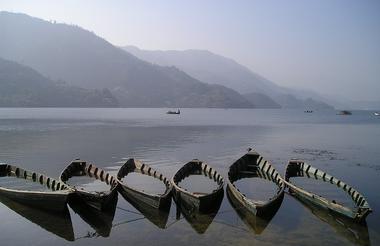
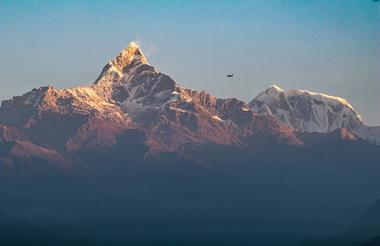
Leisurely breakfast at the hotel
Head out for the sightseeing tour of Bindebashini Temple. It is one of the oldest temples in Pokhara. Legend says that when Pokhara was a part of Kaski Kingdom, the main deity of the temple, Goddess Durga, was brought from India. Apart from the peace and tranquility that can be felt in this region, the premises of the temple offers a good view of the Himalaya on a clear day. The temple is in the area of the Bazaar; hence, a journey of the old bazaar can be combined with a visit to the temple.
Then visit International Mountain Museum, dedicated to the mountains of Nepal and the mountaineers who have climbed them. The museum displays the history, culture, geology, flora and fauna of the Himalayas.
Also visit Gurkha Museum
Afternoon, take a short hike to the World Peace Pagoda. It is a Buddhist stupa built by the Buddhist monks of the Japanese Nipponzan Fujii organization at a narrow ridge above the Phewa Taal. Well-made stone steps climbs 300 m to the top through the forest grove in 1-1/2 hrs. The top, marked by world peace pagoda, offers a tremendous view of the lake and Pokhara city with the backdrop of Annapurna and Manaslu range. Then drive back to hotel
Enjoy Spa / massage at the hotel (on your own account)
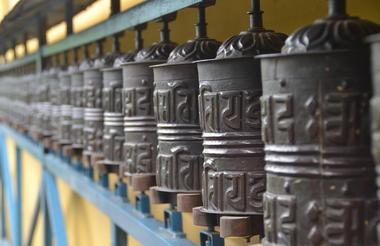


World Peace Pagoda
Breakfast at the Hotel. Then you are transferred to Pokhara airport for your flight back to Kathmandu. Upon arrival in Kathmandu, visit Boudhanath Stupa. Boudhanath Stupa, one of the most imposing landmarks of Kathmandu and also a centre of Tibetan Buddhism. The ancient stupa is one of the largest in the world and a UNESCO World Heritage Site.
Then visit the Buddhist Child Home, an orphanage in Boudha. This is a unique opportunity to interact with the less fortunate kids; who in true sense feel fortunate to be a part of this organization as there are many others yet to be rescued.
Afterwards visit the magnificent temple of Pashupatinath with its astonishing architectural beauty, situated amidst a lush green natural setting on the bank of the sacred Bagmati River. The temple, built in pagoda style, has gilded roof and richly carved silver doors. Dedicated to the Hindu God of Destruction, Lord Shiva, this temple is regarded as the most sacred temple of all Lord Shiva temples. It is listed as a UNESCO World Heritage Site.
Pashupatinath is also Nepal's most renowned Hindu cremation site.
Then you are transferred to Patan City for the night.



The Himalayas has always been a great source of mysticism. The OPTIONAL Mountain Flight offers this rare, fascinating opportunity to embrace the legendary Himalayas and discover the ineffable beauty that is guaranteed to be one of the most mesmerizing experiences ever.
The Mountain Flight is enjoyed by thousands of people every year. The flights are operated by domestic airlines. They are operated only if the weather permits to ensure good visibility and safety. The one-hour Mountain Flight takes off from the Kathmandu Airport to the Everest, a must-see landmark in Nepal and at 8848 m, the highest and most majestic peak in the world. The whole experience is a pure delight; soaring 25,000 ft. above ground, it offers a breathtaking view of the mighty Himalayas. Zipping above clouds, through the seemingly endless scintillating snowcapped peaks, over glaciers and gorges, this is the journey through the world’s highest peaks.
Today enjoy the cultural sightseeing tour of Kathmandu City.
Visit Durbar Square: ‘Durbar’ means ‘palace’, and takes its name from the old Royal Palace. This is the center of the old city, and there are a number of interesting temples. The Kathmandu Durbar Square is a UNESCO World Heritage Site.
The Temple of the Living Goddess: Kathmandu is blessed by a living goddess. The Kumari Devi is the most important of several living goddesses in Nepal. She is seen on the temple’s balcony regularly. A mere sight of her is considered very auspicious by throngs of devotees that seek her blessings.
Take a short walk to Vegetable & spice market in Ason, and see its many courtyards and bustling bazaars.
Then you are transferred to selected local restaurant for the Cooking demonstration on Nepali Cuisine. The Chef will demonstrate the cooking procedures and you will have a chance to see, learn & taste the Local Nepali Cuisine. The lesson will be for an hour.
Afternoon, enjoy the cultural & historical sightseeing tour of Patan City. Patan also known as Lalitpur is the city of artisans and a paradise of fine arts. It is home to Kathmandu Valley’s finest craftsmen who have preserved such ancient techniques and lost wax process used to produce exquisite sculptures. Best known for its cultural heritage, the city retains much of its old charm with its narrow streets, brick houses and multitude of well-preserved Hindu temples, Buddhist monasteries (vihars) and monuments.
In the heart of Patan, amidst the hustle and bustle of the marketplace is the Patan Durbar Square, a UNESCO World Heritage Site. Exquisite works of religious art and architecture, ancient palaces, pagoda temples, Hindu and Buddhist shrines adorn this place. Located in the square is the Patan Museum, formerly a Malla palace, which houses bronze statues and religious objects, some dating back to the 11th century.
Meet with a Kumari, a living goddess, the Kumari. A young fearless pre-pubescent girl of the Newari community is selected and worshipped as a manifestation of the divine Goddess Taleju because of her inherent purity and chastity. People from far and near come to seek her blessings although she is seldom seen by the window of her palace. Hindu people believe that even a glimpse of her brings them good fortune. The Kumari lives away from her family in the Kumari Palace and reigns until her puberty when she is succeeded by a younger girl selected by yet another elaborate selection process.
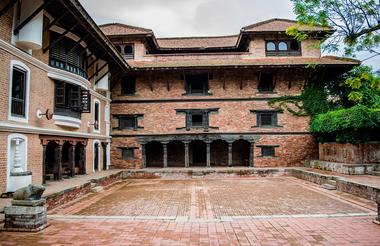
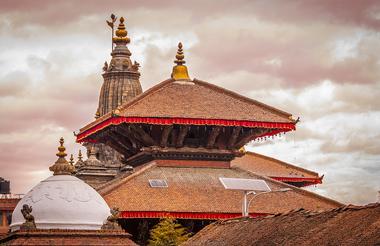

Today you will be transferred to Kathmandu Airport for your flight back home.





